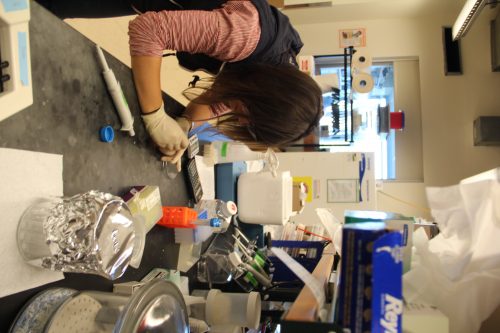Our immune system is the most useful protection we have from the world around us. Until it turns on us. While the immune system is necessary to protect us from the invasion of harmful substances, it is also responsible for numerous rejections of organ transplants every year. One out of every four kidney recipients and almost half of all heart recipients experience an organ rejection within one year of transplant. When donor organs are so few and far between—20 people die each day waiting for a transplant—having your body attack your newly transplanted organ would be unfortunate.
However, scientists are working on various methods of preventing transplant rejections. One team, led by professors Mark Saltzman and Jordan Pober at Yale, is attempting to sneak past the checks of the immune system. They accomplished this by removing the tags on transplanted organs that immune cells recognize and react violently to. To achieve invisibility, they deliver small interfering RNA (siRNA) to the tissue using nanoparticle vehicles. Astonishingly, human arteries pretreated with siRNA-loaded nanoparticles exhibited an 80 percent decrease of the tag. The results are promising for lowering rejection rates of various types of organ transplants, including the most common—the kidney.

Hiding from ourselves
There are currently many approaches to dampening the damaging response of the immune system to transplanted organs. Some groups tackle this challenge by improving immunosuppressive therapy, a treatment in which patients take drugs that reduce the strength of the body’s immune system. But since immunosuppression cripples the entire immune system , it also leads to increased risks of infections, malignancies, other illnesses. There are alternative approaches, such as the modification of the graft after the transplant operation to reduce its ability to activate the immune system.
Saltzman and Pober are looking at this problem in a different way. Instead of tackling the immune system itself, they want to alter the transplant so that it is invisible to the immune system. If the transplant isn’t recognized as alien material, then the immune system wouldn’t have any reason to reject it.
Cells of the immune system monitor the blood for foreign agents, much like guards at a watchtower looking out for intruders. All is peaceful—until the immune system detects a protein called class II major histocompatibility complex (MHC II), found on the surface of the transplant’s endothelial cells. The memory T cell, a type of immune cell, attaches to MHC II, activating and alerting the other parts of the immune system to the foreign tissue and triggering system-wide inflammation in response.
However, if researchers can somehow remove the MHC II proteins alerting the immune system to false danger, the transplanted organ may be able to avoid attack. To reduce the amount of MHC II proteins displayed, researcher can deliver molecules called small interfering RNA (siRNA) to the transplant. Normally, the MHC II proteins are translated, or produced, using a messenger RNA (mRNA) as template. mRNA is a direct copy of DNA, our genetic blueprint, and serves as the instructions for making any type of protein. siRNA works by dismantling mRNA and thus preventing mRNA from participating in translation and thus protein production. However, the delivery of siRNA to the transplant’s endothelial cells, a cell type lining the interior surface of blood vessels, poses some complications. Not only is siRNA unstable, but it also has a hard time permeating the cell membrane.
Scientists have attempted to overcome these challenges by engineering a special delivery vehicle for these siRNA molecules. While these approaches work in test tube conditions, the highly charged delivery vehicles are often cytotoxic inside living organisms. Furthermore, they only hold and release siRNA for up to three days, while the transplant is susceptible to rejection up to several weeks after the operation.
Saltzman and Pober developed a biodegradable nanoparticle called PACE that is able to get the job done. Not only does it hold more siRNA, thereby lengthening the treatment duration, but the nanoparticle also demonstrates long-lasting effects on MHC II reduction in test tubes and in living cells, without damaging the cells The siRNA is released over a longer period of time for increased effectiveness. The resulting reduction of MHC II on the surface of endothelial cells prevented the activation of memory T cells. Without their activation, the rest of the immune system cannot further damage the endothelial cells of the transplanted organ.
Furthermore, the timing of PACE delivery in relation to the transplant operation gives the approach an advantage. Before a transplant operation, the donor organ is kept perfused with blood ex vivo, that is, outside the body, using a machine. The perfusion system preserves the quality of the organ. “We recognized that if the organ is ex vivo, being perfused with blood, there is an opportunity for treatment during this period,” Saltzman said.
Thus, instead of injecting the patient post-operatively with siRNA-loaded nanoparticles, healthcare providers may be able to first treat the donor organs with nanoparticles and then carry out a transplant procedure.
Tuning the nanoparticles
There are many characteristics and features of a nanoparticle that can be optimized. “Toxicity, how readily they are taken up [by endothelial cells], how slowly they release siRNA, and how much siRNA they can carry are all important,” Saltzman said.
The potential of their nanoparticle delivery system shines through in several key experiments. The team of researchers pretreated human arteries with siRNA-loaded nanoparticles for 6 hours ex vivo. They then transplanted these treated arteries into mice lacking a functioning immune system, so the arteries would be accepted. This led to remarkable results, reducing MHC II expression in the transplanted arteries for up to six weeks after the transplant. “We tuned the nanoparticles to slowly release the siRNA,” Saltzman said. They were also able to demonstrate that when an ex vivo siRNA-treated human artery was transferred from a donor mouse to a recipient mouse, the artery was protected from T cell infiltration, meaning that in a mouse model, at least, the arteries could be transplanted without rejection.
These findings have many future implications for organ transplant success. Already, the research team has shown the successful delivery of nanoparticles without siRNA into kidneys ex vivo. “We are initially proposing to test the benefits of reducing expression of the molecules most strongly targeted by the recipient’s immune system,” said Jordan Pober. After this step, the scientists may move on to further trials to test the new technology on organ transplants. With 25,000 organs transplanted a year, the reduction of organ rejection would improve the lives of many thousands for the better.
Extra Reading
Ennio Tasciotti, Fernando J. Cabrera, Michael Evangelopoulos, Jonathan O. Martinez, Usha R. Thekkedath, Malgorzata Kloc, Rafik M. Ghobrial, Xian C. Li, Alessandro Grattoni, and Mauro Ferrari. 2016. “The Emerging Role of Nanotechnology in Cell and Organ Transplantation.” Transplantation 100(8): 1629-1638.

